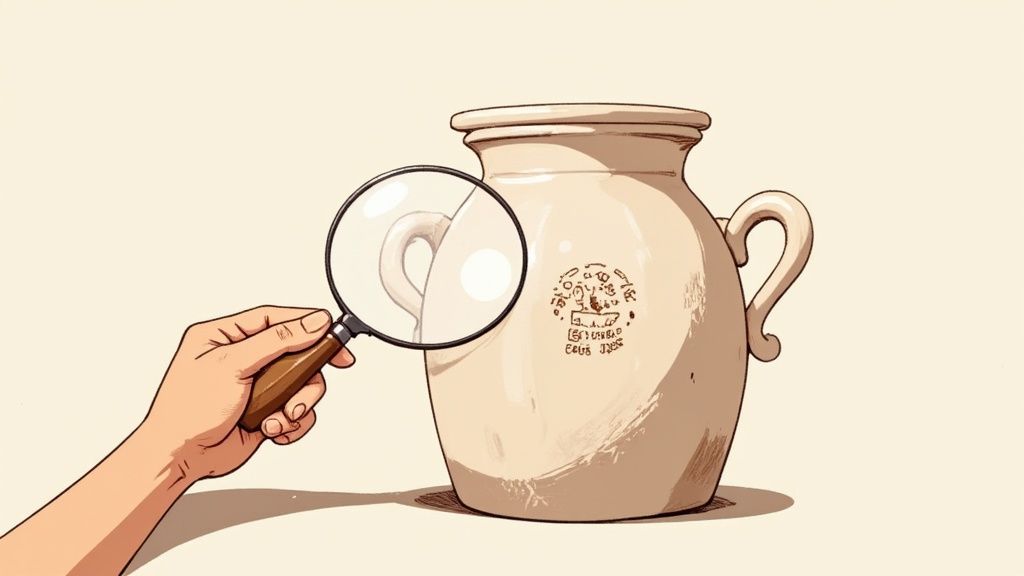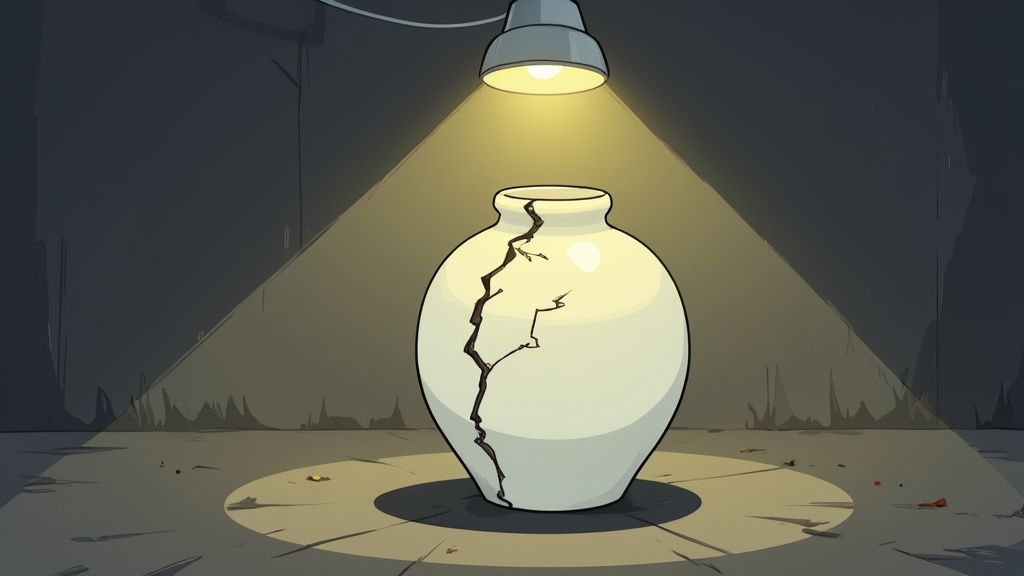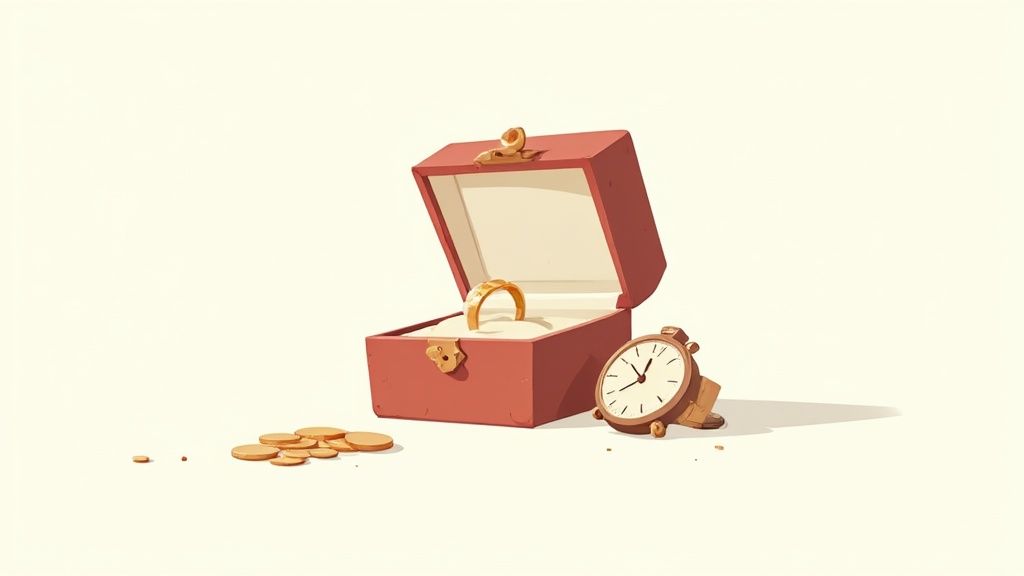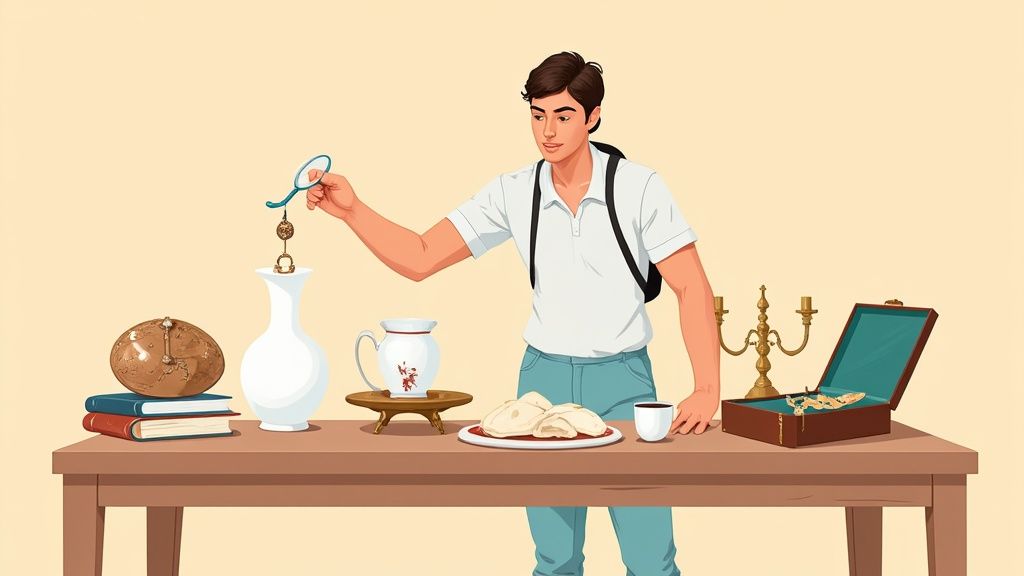Unlocking the Hidden Treasures: Your Ultimate Estate Sale Guide
Estate sales are more than just a homeowner's collection; they are time capsules filled with stories, history, and potential treasures waiting to be rediscovered. For the seasoned collector, savvy reseller, or curious novice, knowing precisely what to look for at estate sales can transform a casual weekend outing into a profitable and thrilling adventure. It’s a unique hunt where knowledge is your most valuable tool, allowing you to spot overlooked gems, identify authentic antiques, and negotiate prices with confidence.
The difference between walking away with a priceless find and leaving empty-handed often comes down to strategy and a keen eye for detail. This guide is designed to equip you with the essential insights needed to navigate these sales effectively. We'll explore eight critical strategies, moving beyond generic advice to provide actionable steps, real-world examples, and the specific signs of value that separate the mundane from the magnificent.
By understanding how to research marks, inspect for condition, and even where to look, you'll be prepared to uncover the incredible value hidden in plain sight. Prepare to elevate your estate sale game and start finding the treasures that others miss.
1. Arrive Early on the First Day
In the competitive world of estate sales, the most crucial strategy isn't about what you look for, but when you look for it. Arriving early on the first day, typically a Friday, is the single most effective tactic for securing high-value, rare, and desirable items. This is because professional dealers, seasoned collectors, and dedicated resellers all know this golden rule. They will be there, often lining up well before the doors open, ready to claim the best inventory. While prices are at their firmest on day one, the quality and selection are unparalleled.

This "early bird" approach is a calculated trade-off. You sacrifice the potential for end-of-sale discounts for the exclusive opportunity to survey the entire, untouched contents of a home. This gives you the time and space to conduct thorough inspections in a less chaotic environment. For those hunting specific items, like a piece of signed mid-century modern furniture or a rare collection of vintage vinyl, arriving early is not just an advantage, it is essential. The most sought-after pieces are often gone within the first 30 minutes of a sale opening.
How to Implement This Strategy
To make the most of your early arrival, preparation is key. Don't just show up at opening time; aim to be there 30 to 60 minutes beforehand for sales that have been advertised with high-value items.
- Scout Online First: Thoroughly review the sale listing and photos on websites like EstateSales.net or the company's own site. Identify your primary and secondary targets before you even leave home.
- Prepare Your Toolkit: Bring a small bag with essentials. This should include a flashlight for inspecting dark corners or maker's marks, a measuring tape for furniture, and a loupe for examining jewelry or signatures.
- Have Cash Ready: While many sales now accept cards, cash is still king. It's faster, universally accepted, and can sometimes give you leverage. Having small bills makes transactions quick and easy.
- Know the System: Some companies hand out numbers upon arrival to manage entry. Understand the process so you can secure your place in line and enter in an orderly fashion.
2. Research Quality Makers and Marks
Beyond just spotting something that looks old, the real secret to discovering treasures at estate sales lies in deciphering the language of the creators. Learning to identify maker's marks, signatures, and construction hallmarks is a powerful skill that allows you to see value where others see only an object. This knowledge transforms you from a casual browser into a detective, hunting for the subtle clues that separate a mass-produced item from a valuable, artisan-crafted piece. A simple stamp on the bottom of a vase or a specific type of joint on a drawer can be the key to a significant find.

This investigative approach is what separates seasoned collectors from novices. Anyone can pick up a pretty piece of pottery, but only someone who has done their homework might recognize the distinctive glaze of an unsigned Rookwood piece or the specific hallmarks indicating sterling silver versus silver plate. Similarly, knowing that a piece of furniture uses dovetail joints and is made of solid walnut points to a higher level of quality and potential value, even without a visible maker's stamp. This expertise allows you to confidently assess items on the fly, making quick, informed decisions in the fast-paced environment of a sale. It is one of the most reliable ways to build a collection of authentic, high-quality pieces.
How to Implement This Strategy
Turning knowledge into profitable finds requires a dedicated, focused approach. You don't need to be an expert in everything, but becoming one in a few key areas can yield incredible results.
- Focus Your Study: Instead of trying to learn every mark, concentrate on categories you are passionate about, like art pottery, mid-century furniture, or jewelry. This makes learning more enjoyable and effective. To start, you can learn more about vintage pottery marks to build a foundational knowledge base.
- Create a Digital Toolkit: Use your smartphone as a mobile research station. Apps like Google Lens can help with initial identification, while subscription services like WorthPoint or LiveAuctioneers provide auction records and detailed mark guides.
- Carry Essential Gear: A jeweler's loupe or a simple magnifying glass is non-negotiable for examining small, intricate marks on silver, jewelry, and ceramics. A small flashlight can also help illuminate faint stamps in dark corners or underneath furniture.
- Document and Research: If you're unsure about a mark but the item has potential, don't be afraid to take a clear photo of it. You can research it later or even post it to online forums for identification help from other collectors.
3. Inspect for Damage and Authenticity
Beyond simply identifying a promising item, the most critical step when deciding what to look for at an estate sale is a thorough hands-on inspection. The excitement of finding a potential treasure can cloud judgment, but taking a moment to meticulously examine an item for damage, repairs, and signs of authenticity is what separates a great find from a costly mistake. Many valuable pieces have hidden flaws or are clever reproductions, and understanding these details is crucial for determining true worth.

This detailed assessment is where you confirm an item's story and condition. For example, a piece of Roseville pottery might look perfect from a distance, but a hairline crack only visible when held up to light could reduce its value by over 70%. Similarly, an antique-looking chest of drawers might be a modern reproduction, identifiable by its perfectly uniform screws and modern joinery techniques instead of handcrafted dovetails. Recognizing these nuances ensures you pay a fair price and truly understand what you are buying.
How to Implement This Strategy
A tactile and visual approach is essential. Don't be afraid to pick items up (carefully!) and use your senses to uncover their secrets. This process should become a reflexive habit for every item you consider purchasing.
- Use Light and Touch: Hold glassware and ceramics up to a window or use your phone's flashlight. This technique, called candling, makes hairline cracks, chips, and repairs much easier to spot. Run your fingers slowly along the rims and edges of dinnerware and pottery to feel for tiny nicks that the eye might miss.
- Check for Consistent Aging: An authentic antique should show signs of age that are consistent across the entire piece. Look for a uniform patina on metal, natural wear patterns on furniture where hands would rest or drawers would slide, and consistent crazing in ceramic glazes. Be wary of pieces that look too new in some places and artificially aged in others.
- Verify Maker's Marks and Signatures: For signed artwork, jewelry, or pottery, compare the mark or signature to known, verified examples online. A quick search on your smartphone can prevent you from buying a forgery. This is especially important for jewelry, where stamps and hallmarks are key indicators of authenticity. You can learn more about how to identify antique jewelry and its markings.
- Look Underneath and Inside: The bottom and back of an item often tell the truest story. Check the underside of furniture for modern hardware, plywood, or particleboard. Look inside drawers and cabinets for signs of construction that don't match the period.
4. Focus on Small, High-Value Items
While large furniture pieces and major artworks grab attention, the most significant profits are often found in the smallest packages. Focusing on small, high-value items like jewelry, coins, watches, and other collectibles is a smart strategy. These items are frequently overlooked or misidentified by estate sale organizers who are overwhelmed with clearing an entire home. They can be tucked away in drawers, shoeboxes, or coat pockets, waiting for a discerning eye to uncover their true worth. This approach maximizes your potential return on investment while minimizing issues with transport and storage.

The "small treasures" method is a game of details and diligence. A tangled box of "costume" jewelry might contain a 14k gold chain, or a jar of pocket change could hold a rare silver coin. Similarly, a vintage designer scarf might be bundled with common accessories. Success here relies on your ability to spot subtle clues of value that others miss. Because these items are portable and often underpriced, they represent some of the best finds when considering what to look for at estate sales. They are easy to purchase, carry out, and research later for a potentially substantial profit.
How to Implement This Strategy
To effectively hunt for small valuables, you must be methodical and come equipped with the right tools and knowledge. Slow down and be prepared to dig through areas that most shoppers skim over.
- Systematically Check Bedrooms and Closets: Patiently go through every drawer in dressers, nightstands, and jewelry armoires. Check the pockets of old coats, suits, and purses, as these are common hiding spots for forgotten cash, jewelry, or important keepsakes.
- Bring Magnification: A jeweler's loupe is an indispensable tool. It allows you to read tiny hallmarks on sterling silver (925), gold (10k, 14k, 18k), and platinum (PLAT, 950). It also helps you examine the details of watches, signatures on small art, and the condition of coins.
- Don't Dismiss Costume Jewelry: While looking for precious metals, remember that signed costume jewelry from designers like Miriam Haskell, Chanel, or Schiaparelli can be extremely valuable. Learn to recognize designer marks and construction styles.
- Know Your Metals: Have a basic understanding of current precious metal prices. This knowledge lets you quickly calculate the "scrap" or melt value of a gold or silver item, establishing a baseline price you should not exceed.
5. Negotiate Strategically
While discovering treasures is the goal, how you purchase them is just as important. Estate sale pricing is not always set in stone; it's a dynamic system with built-in flexibility. Understanding when and how to negotiate strategically is a key skill for any serious shopper, transforming a good find into a great deal. Unlike retail stores, estate sales are designed to liquidate an entire household's contents in a short period, creating opportunities for negotiation, especially on later days or for bulk purchases.
This approach is about more than just asking for a lower price. It's about recognizing the motivations of the sale organizers, which shift as the weekend progresses. On Friday, prices are firm. By Sunday, the primary goal is to empty the house. This is your window of opportunity. Bundling items, like an entire set of kitchenware or multiple pieces of artwork from the same artist, gives you significant leverage. You are helping the company achieve its goal, which makes them more receptive to offering a discount. This is a crucial part of knowing what to look for at estate sales: not just the item, but the opportunity for a better price.
How to Implement This Strategy
Successful negotiation is a blend of timing, respect, and preparedness. Being polite and reasonable is far more effective than being demanding.
- Wait for the Right Time: The best time to negotiate is typically on the last day of the sale, usually a Sunday. Many companies advertise 50% off on the final day, but even then, there can be room for discussion on large or multiple items.
- Bundle for a Better Deal: Don’t negotiate on a single, low-cost item. Instead, gather several pieces you're interested in. Approach a staff member and make a reasonable "bundle" offer for the entire lot. For example, "I've got this lamp, these three books, and this set of frames. Would you take $50 for all of it?"
- Be Respectful and Realistic: Always be polite. Remember that the sale represents someone's life and belongings. Start with a reasonable offer, not an insulting lowball price. An offer of 15-25% below the asking price on a negotiable day is a fair starting point.
- Use Cash as a Tool: Having cash ready, especially for a bundled offer, makes the transaction quick and appealing for the staff. It simplifies their process and can make them more likely to accept your offer.
6. Bring Proper Tools and Supplies
While knowing what to look for at estate sales is crucial, being properly equipped to assess and acquire those finds is what separates a novice visitor from a serious buyer. Arriving with the right tools transforms your shopping experience from a casual browse into a professional evaluation. This preparation allows you to make informed decisions on the spot, verify an item’s authenticity, confirm its condition, and ensure you can actually transport your purchases. Seasoned shoppers never leave home without their toolkit, as it provides the confidence needed to invest in potentially valuable items.
This proactive approach is about efficiency and risk mitigation. Without a measuring tape, you risk buying a beautiful dresser that won't fit through your doorway. Without a loupe, you might overlook a tiny maker's mark that quadruples a piece of jewelry's value, or worse, miss a flaw that renders it worthless. Having these supplies on hand means you can act decisively while others hesitate. It empowers you to perform due diligence quickly in a competitive environment, ensuring you don't pass up a great deal or make a costly mistake.
How to Implement This Strategy
Assembling a dedicated estate sale kit ensures you are ready for any opportunity. Keep these items in a small, easy-to-carry bag or stored in your vehicle so you’re always prepared.
- Create Your Assessment Toolkit: Pack a small bag with essentials. This should include a tape measure for furniture, a jeweler's loupe for inspecting hallmarks on silver and jewelry, and a small, powerful flashlight to examine items in poorly lit basements or attics.
- Plan for Logistics: If you're hunting for large items, think ahead. Bring a friend or family member to help you move heavy furniture. Ensure your vehicle is large enough, or have the contact information for a local moving or delivery service ready.
- Carry Cash and Packing Materials: While cards are common, cash remains the fastest way to transact and can sometimes be used for negotiation. Bring a mix of bills. Also, keep bubble wrap, old blankets, or boxes in your car to safely transport fragile purchases.
- Use Digital and Physical References: Have your smartphone fully charged. Use it to quickly look up artist signatures, brand names, or comparable prices online. For specialized areas like pottery or stamps, a pocket reference guide can be invaluable.
7. Check Hidden and Unusual Spaces
While many shoppers focus on the prominent displays of furniture and decor, some of the most valuable finds at an estate sale are tucked away in forgotten corners. The true art of what to look for at estate sales involves a systematic treasure hunt through the less-obvious areas. Basements, attics, garages, and even the depths of closets often hold items that were stored away and forgotten, missed during the initial pricing, or simply deemed too mundane by less experienced shoppers. This is where you can unearth everything from valuable tool collections to vintage clothing in pristine condition.
This strategy is about exercising diligence and curiosity beyond the main living areas. Most buyers follow a predictable path through a home, but the real opportunities often lie where others don't bother to look. A dusty box in the corner of a garage could contain rare automotive manuals or antique hand tools. A forgotten suitcase in an attic might hold a collection of vintage travel souvenirs or designer accessories. By committing to a thorough search, you significantly increase your chances of discovering items that have been completely overlooked, often available at a fantastic price simply due to their hidden location.
How to Implement This Strategy
A successful hunt in hidden spaces requires a methodical approach and a keen eye. Don't just glance; actively investigate these often-cluttered areas.
- Systematically Search Storage Areas: Dedicate specific time to the garage, basement, attic, and sheds. Look inside every cabinet, box, and container. Safely move items to see what might be behind or under them.
- Inspect All Closets and Drawers: Don't assume drawers are empty. Gently open dresser drawers, nightstand drawers, and kitchen cabinets. Always check the pockets of coats, jackets, and purses, as people often forget cash, jewelry, or other small valuables.
- Look Inside Containers: Go through sewing baskets, tackle boxes, and desk organizers. These specialized containers often hold vintage supplies, rare fishing lures, or collectible fountain pens that are valuable to niche collectors.
- Don't Dismiss the Unkempt: Grime and dust often deter other buyers, but they can also preserve items. A dirty box in the basement might be protecting a set of rare books or a stack of first-edition comics from light and handling. Be prepared to see past the dirt to the potential underneath.
8. Understand Pricing Patterns and Sale Progression
A savvy estate sale shopper understands that timing is just as important as having a good eye. Beyond just arriving early, a key strategy for success is knowing the predictable pricing patterns that most sales follow over their two or three-day run. Companies orchestrating these events aim to liquidate an entire household's contents, and their pricing model is designed to achieve this. Day one is for full-price, high-demand items, while subsequent days introduce progressive, often steep, discounts to ensure everything sells. Knowing this rhythm is crucial when deciding what to look for at estate sales, as it allows you to balance cost against the risk of an item being sold.

This strategy is about making calculated decisions. For a rare, signed piece of artwork you've been searching for, paying full price on Friday is a necessity. However, for more common items like kitchenware, books, or decorative pieces where multiple similar options exist, waiting for the 50% off final day is a much smarter financial move. By aligning your purchasing goals with the sale's timeline, you can optimize your budget, securing essential finds early while saving significantly on secondary wants. This tiered approach maximizes both your collection and your wallet. For more insights on this topic, you can learn more about how estate sale items are priced at Curio.app.
How to Implement This Strategy
Successfully navigating the sale's progression requires a plan. You must decide which items are "must-haves" and which are "nice-to-haves" before the doors even open.
- Buy "Must-Haves" Immediately: If you see an item you cannot live without or that is central to your collection or resale business, buy it on the first day. Do not risk it being gone.
- Return on Discount Days: For general stock, like tools, linens, or everyday dishes, plan a return trip on Saturday (often 25-30% off) or Sunday (typically 50% off or more). The savings can be substantial.
- Ask About the Schedule: Don't be afraid to politely ask the staff about their discount structure. Many will tell you the plan, for instance, "Saturday is 25% off, and Sunday is 50% off everything before noon."
- Monitor Popular Items: If you are on the fence about a larger item like furniture, you can leave your name and number. Sometimes, if it hasn't sold by the end of the first day, the company may call you with an early offer.
Key Factors to Consider at Estate Sales: 8-Point Comparison
| Strategy | Implementation Complexity 🔄 | Resource Requirements ⚡ | Expected Outcomes 📊 | Ideal Use Cases 💡 | Key Advantages ⭐ |
|---|---|---|---|---|---|
| Arrive Early on the First Day | Moderate 🔄 | Low to Moderate (time investment) ⚡ | Access to best selection, rare finds 📊 | Securing high-value items early in sale start | First pick advantage, thorough inspection ⭐ |
| Research Quality Makers and Marks | High 🔄 | High (time, research tools) ⚡ | Spot undervalued items, confident buys 📊 | Identifying hidden valuable items by marks/signatures | Increased buying accuracy, profit potential ⭐ |
| Inspect for Damage and Authenticity | Moderate to High 🔄 | Moderate (tools like flashlight, UV) ⚡ | Avoid damaged items, negotiate better 📊 | Confirming condition and authenticity of items | Reduced risk, price leverage ⭐ |
| Focus on Small, High-Value Items | Moderate 🔄 | Low to Moderate (knowledge, loupe) ⚡ | Efficient investment, easy transport 📊 | Hunting jewelry, coins, small collectibles | High value-to-size ratio, good resale ⭐ |
| Negotiate Strategically | Moderate 🔄 | Low (cash ready, tact) ⚡ | Savings, bulk discounts, better deals 📊 | Getting price reductions, especially late sale days | Cost savings, relationship building ⭐ |
| Bring Proper Tools and Supplies | Moderate 🔄 | Moderate to High (tools, packing supplies) ⚡ | More effective evaluation and transport 📊 | Professional setup for thorough shopping and handling | Better assessment, safe transport ⭐ |
| Check Hidden and Unusual Spaces | Moderate 🔄 | Low to Moderate (time, effort) ⚡ | Discover overlooked valuable items 📊 | Comprehensive searching in less obvious locations | Finds missed by others, unique pieces ⭐ |
| Understand Pricing Patterns and Sale Progression | Moderate 🔄 | Low to Moderate (time, visits) ⚡ | Optimized timing and budget usage 📊 | Planning purchases over multi-day estate sales | Maximize savings and selection ⭐ |
Turn Your Discoveries into a Lifelong Passion
The world of estate sales is more than just a marketplace; it's a living museum where every item holds a fragment of a story. As you've seen, mastering what to look for at estate sales is an art form that blends sharp observation, strategic planning, and a genuine curiosity for the past. Moving beyond the casual browse and applying these detailed techniques will fundamentally transform your experience, turning a weekend hobby into a rewarding, lifelong passion.
From Novice Hunter to Seasoned Expert
The journey begins with preparation. By arriving early on the first day, you gain the crucial advantage of first choice, accessing the most sought-after items before the crowds descend. This simple act, combined with diligent pre-sale research into quality makers and their identifying marks, sets the foundation for every successful find. You are no longer just looking at old things; you are actively seeking specific indicators of value and craftsmanship that others might overlook.
Meticulous inspection is where your knowledge truly shines. Knowing how to spot subtle signs of damage, clever repairs, or the telltale marks of a reproduction separates the serious collector from the amateur. Remember to look beyond the obvious, focusing on those small, high-value items like jewelry, coins, and ephemera that are often tucked away. These easily portable treasures can represent some of the most significant discoveries at any sale.
The Strategic Art of the Acquisition
Your approach to the sale itself is just as important as your eye for value. Negotiating respectfully and strategically, especially as the sale progresses into its final days, is a skill that directly impacts your bottom line. Understanding the psychology of pricing, from firm first-day prices to deep last-day discounts, allows you to time your purchases for maximum value.
Don't forget the practicalities. Arriving with the right tools, a fully charged phone for on-the-spot research, and appropriate supplies for packing your finds ensures you can act decisively when you unearth something special. This level of preparedness, which includes a willingness to check attics, basements, and the back of closets, is often what leads to uncovering those hidden gems that make the entire hunt worthwhile.
Your Next Steps into a Storied World
Each estate sale is a new classroom and a fresh adventure. The key is to see every outing as an opportunity to refine your skills. Keep a running list of makers you want to find, practice identifying materials, and never stop learning. The real value lies not just in the objects you acquire but in the expertise you build and the stories you preserve. You are becoming a curator of personal histories, a rescuer of forgotten treasures, and a savvy investor all at once. The past is waiting to be discovered, and with these insights, you are perfectly equipped to uncover its most fascinating secrets.
Ready to take your identification skills to the next level and instantly learn the story behind your finds? Download Curio to use powerful image recognition that helps you identify, value, and catalogue the treasures you discover at your next estate sale. Turn your phone into your most powerful tool for uncovering history.
